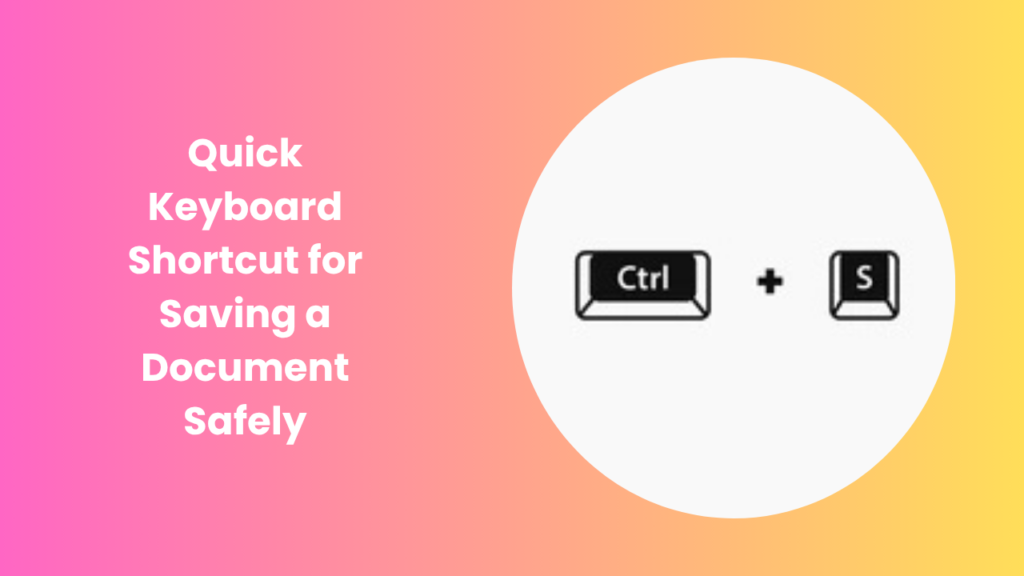In today’s fast-paced digital world, almost everything we create is stored on computers or online platforms. Whether you are drafting a business proposal, writing an academic essay, editing photographs, or building a presentation, the value of your work lies not only in the effort you invest but also in the safety of its storage. Imagine spending hours preparing a document only to lose it because of a sudden system crash or an accidental closure. These frustrating moments are more common than many would like to admit, and they highlight the importance of one simple habit saving your work regularly.
While most people are aware of the “save” button hidden in menus, there is an even faster and more reliable approach. The keyboard shortcut for saving a document gives you the ability to preserve your progress instantly, keeping interruptions to a minimum. This shortcut is widely recognized across countless programs, which makes it not only useful but also universal. Understanding its role, practicing it daily, and pairing it with other good habits can transform the way you work digitally. In this guide, we will explore why saving documents efficiently matters, how the shortcut works, what misconceptions exist, and why making it a habit ensures that your ideas and hard work are never lost.
Why Saving Documents Efficiently Matters
The importance of saving documents efficiently cannot be overstated. In an environment where work is often complex, detailed, and time-sensitive, protecting progress is critical. Losing a file not only costs you the effort already spent but can also delay projects, reduce motivation, and even cause financial setbacks for professionals working under deadlines.
Efficient saving habits are not just about securing files against crashes or shutdowns; they are also about maintaining a smooth workflow. Every interruption caused by retracing lost steps drains productivity. By adopting efficient saving practices, you create an uninterrupted process where creativity and focus stay intact. This is especially vital in industries such as content creation, research, programming, or design, where even small details can take significant time to reproduce.
Understanding the Keyboard Shortcut for Saving a Document
The keyboard shortcut for saving a document is among the simplest yet most powerful tools available to computer users. On Windows systems, pressing Ctrl + S will immediately save your progress, while macOS users can achieve the same result with Command + S. If the document is being saved for the first time, the program prompts you to choose a location and a file name before finalizing the save.
The beauty of this shortcut lies in its universality. From popular tools like Microsoft Word, Excel, and Google Docs to professional software such as Photoshop or coding environments, the shortcut behaves the same way. This means once you master it, the knowledge carries over seamlessly across different applications. Instead of pausing to navigate through a menu, you can continue typing, designing, or editing without losing your rhythm.
How Shortcuts Enhance Productivity
Shortcuts are built to eliminate unnecessary steps in daily computer use. By replacing multiple clicks with a quick key combination, you cut down on wasted moments. Saving files is one of the most repetitive tasks we perform, and having the ability to do it instantly through a shortcut streamlines the process significantly.
Another major benefit is the preservation of concentration. Creative tasks often rely on maintaining momentum. Having to stop mid-thought, grab the mouse, and search for the save button can interrupt the natural flow of work. A single keystroke, however, maintains your immersion, enabling ideas to flow uninterrupted. Over time, this accumulated efficiency makes a noticeable difference, particularly in professional or academic settings where deadlines and output quality are critical.
Common Misconceptions About Shortcuts
Despite their simplicity, many users underestimate shortcuts or assume they are reserved for advanced users. The reality is the opposite—shortcuts are designed for accessibility and ease. The save shortcut is intuitive because the letter “S” is directly associated with the word “save.” A few repetitions are often enough to engrain the habit into muscle memory.
Another misconception is that saving once is enough to secure your progress. In truth, saving should be done frequently, especially during demanding tasks. Shortcuts make this easy and fast, so saving repeatedly becomes second nature. This practice drastically reduces the risk of losing valuable updates and provides reassurance that your latest version is always secure.
The Role of Auto-Save Features
Auto-save has become a standard in modern applications, especially cloud-based platforms. It provides a safety net by continuously storing your work in the background. While this feature is extremely useful, it should not replace manual saving altogether. Auto-save often works at set intervals, meaning the most recent edits might not be preserved if the program crashes unexpectedly.
Manual saving through shortcuts gives you direct control. Even when working with programs that have robust auto-save features, using the shortcut reinforces your confidence that the latest changes are locked in place. The two methods complement each other, with auto-save acting as a backup and manual shortcuts providing certainty.
Developing a Habit of Saving Smartly
Building the habit of using shortcuts requires intentional practice. At first, you may need to remind yourself to press the keys regularly, but over time the motion becomes automatic. A practical approach is to save whenever you pause, switch tasks, or finish a significant section of your work. This repeated action turns saving into second nature.
The benefits of this habit extend beyond preventing loss. It also contributes to smoother workflows and greater peace of mind. Instead of working with lingering anxiety about potential data loss, you can focus entirely on the task at hand. This small adjustment in behavior has a large impact on efficiency and long-term productivity.
FAQs
Why is saving a document so important?
Saving ensures that your progress remains intact in case of system failures, unexpected shutdowns, or accidental program closures. Without saving, hours of work can disappear instantly, forcing you to start from scratch.
Do all applications support saving shortcuts?
Most modern applications, particularly those for writing, editing, and designing, recognize the shortcut. However, some older or specialized programs may not, so it is always advisable to confirm with the software’s help guide.
How does saving differ on Windows and Mac?
The process is the same, but the keys differ: Windows uses Ctrl + S, while Mac uses Command + S. Both achieve the same result, which is storing your progress immediately.
Does auto-save eliminate the need for manual saving?
Not entirely. Auto-save is extremely useful, but it cannot always capture your most recent updates. Manual saving gives you full control and ensures that your latest work is protected.
Can shortcuts be customized?
Some advanced programs allow users to customize shortcuts according to preference. While the default save shortcut is standardized, customization provides flexibility for those who prefer alternative commands.
What if my shortcut does not work?
If the shortcut fails, it may be due to hardware issues, program limitations, or conflicting commands in system settings. In such cases, manual saving via the menu is still a reliable alternative.
Is there a risk of overwriting files with the save shortcut?
Yes, using the shortcut will overwrite the existing file with the new changes. If you want to preserve multiple versions, you should use the “Save As” function, which creates a new copy without affecting the original file.
Conclusion
In the digital age, where most of our work is created, stored, and shared electronically, developing smart saving habits is one of the simplest yet most effective ways to protect productivity. The keyboard shortcut for saving a document stands out as a universal and reliable method that ensures your effort is never wasted. By adopting it, you gain the advantage of speed, efficiency, and peace of mind, all while reducing the risk of losing important files to unforeseen problems.
Forming this habit may seem small, but over time it becomes a cornerstone of effective computer use. It enables smoother workflows, greater confidence in your progress, and protection against setbacks. Whether you are a student, a professional, or someone who uses digital tools casually, mastering this shortcut empowers you to focus on creativity and accuracy rather than worrying about potential data loss.





